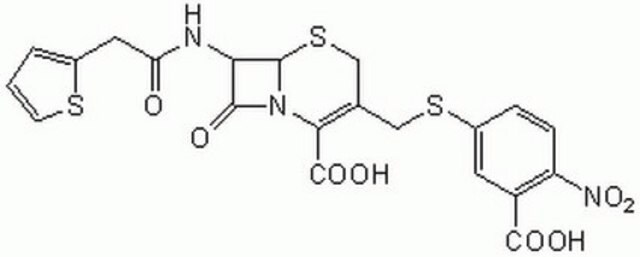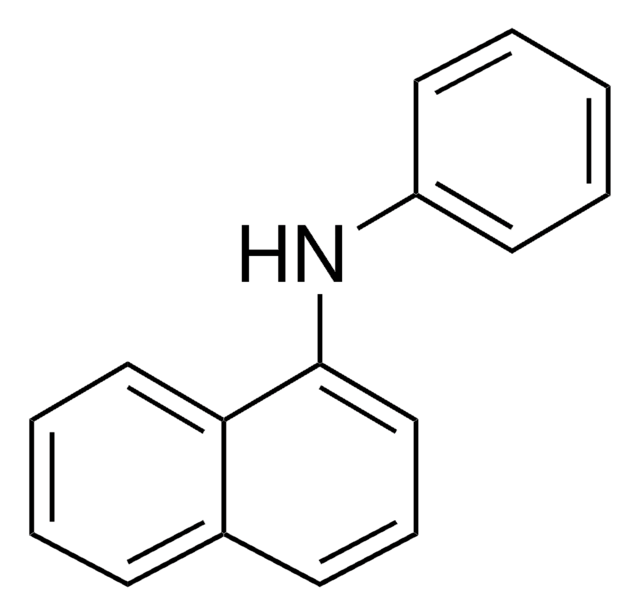484400
Nitrocefin
≥95% (UV), solid, β-lactamase substrate, Calbiochem®
Synonym(s):
Nitrocefin, 3-(2,4-Dinitrostyryl)-(6R, 7R)-7-(2-thienylacetamido)-ceph-3-em-4-carboxylic Acid, E-isomer
About This Item
Recommended Products
product name
Nitrocefin, A chromogenic β-lactamase substrate that undergoes distinctive color change from yellow as the amide bond in the β-lactam ring is hydrolyzed by β-lactamase.
Quality Level
Assay
≥95% (UV)
form
solid
manufacturer/tradename
Calbiochem®
storage condition
OK to freeze
protect from light
color
orange-yellow
shipped in
ambient
storage temp.
−20°C
InChI
1S/C21H16N4O8S2/c26-16(9-14-2-1-7-34-14)22-17-19(27)23-18(21(28)29)12(10-35-20(17)23)4-3-11-5-6-13(24(30)31)8-15(11)25(32)33/h1-8,17,20H,9-10H2,(H,22,26)(H,28,29)/b4-3+/t17-,20-/m1/s1
InChI key
LHNIIDJCEODSHA-OQRUQETBSA-N
General description
Packaging
Warning
Preparation Note
• Dissolve 1 mg Nitrocefin in 100 µl dimethylsulfoxide (DMSO) and vortex.
• Add 1.9 ml phosphate buffer (100 mM, pH 7) to produce 2 ml total volume.
• This yields a working Nitrocefin solution of 500 µg/ml (~1 mM), which is suitable for most applications.
• Nitrocefin, particularly in solution, is very sensitive to light.
Reconstitution
Other Notes
King, A., et al. 1980. Antimicrob. Agents Chemother. 17, 165.
Matthew, M., et al. 1975. J. Gen. Microbiol. 88, 169.
O’Callaghan, C.H., et al. 1972. Antimicrob. Agents Chemother. 1, 283.
Legal Information
Signal Word
Danger
Hazard Statements
Precautionary Statements
Hazard Classifications
Eye Dam. 1 - Skin Irrit. 2 - Skin Sens. 1
Storage Class Code
11 - Combustible Solids
WGK
WGK 3
Regulatory Listings
Regulatory Listings are mainly provided for chemical products. Only limited information can be provided here for non-chemical products. No entry means none of the components are listed. It is the user’s obligation to ensure the safe and legal use of the product.
JAN Code
484400-5MG:
484400-0MG:
484400-100MG:
484400-MG:
Certificates of Analysis (COA)
Search for Certificates of Analysis (COA) by entering the products Lot/Batch Number. Lot and Batch Numbers can be found on a product’s label following the words ‘Lot’ or ‘Batch’.
Already Own This Product?
Find documentation for the products that you have recently purchased in the Document Library.
Customers Also Viewed
Our team of scientists has experience in all areas of research including Life Science, Material Science, Chemical Synthesis, Chromatography, Analytical and many others.
Contact Technical Service















